LED Streetlight Lioris Aduro 52
Posted by Marcel van der Steen in Led lights, Light measurements Add commentsLioris comes with a street lamp equipped with LEDs. In this article the 52 LEDs version is measured. The street light is so robust that the LEDs do not run hot. This will positively impact their lifetime. Also available are the measurement data in Eulumdat format. The measurements were done without the transparent cover of this lamp.
See this overview for a comparison with other lightbulbs.
Summary measurement data
| parameter | meas. result | remark |
|---|---|---|
| Color temperature | 5510 K | Bright white. |
| Luminous intensity Iv | 558 Cd | |
| Beam angle | 137 deg | A wide beam. This is the average value. To different directions this light has a different beam (by design). |
| Power P | 58.8 W | |
| Power Factor | 0.94 | For every 1 kWh net power consumed, there has been 0.38 kVAhr for reactive power. |
| Luminous flux | 3767 lm | |
| Luminous efficacy | 64 lm/W | |
| CRI_Ra | 71 | Color Rendering Index. |
| Coordinates chromaticity diagram | x=0.332 and y=0.351 | |
| Fitting | 230V | Needs connection to 230 V grid voltage. |
| L x B x H external dimensions | 760 x 240 x 150 mm | Maximum dimensions |
| L x B dimensions of luminous area | 350 x 195 mm | For this light the leds are situated in a bucket that reflects light. Herewith given are the dimensions of this bucket. The concept of luminous area is used in programs as Dialux / Relux. |
| General remarks | The ambient temperature during the whole set of measurements was 20.0 – 21.5 deg C.
Warm up effect: no effect. Voltage dependency: power and illuminance are dependent on the lamp voltage. For all raw measurement data follow this link (lioris-aduro-52_zonderkap.zip). For the Eulumdat file follow this link (lioris-aduro-52_eulumdat_c0_90degcw1.ldt). |
Light diagram in Eulumdat format
This streetlamp is specifically designed to generate light at the needed spots underneath the lamp. Also to generate no light where this is not needed. The light pattern diagram in Eulumdat format show where the light is radiated to.
Light diagram giving the radiation pattern in the C0-C180 and the C90-C270 plane.
This diagram shows the intensity pattern for the planes C0-C180 and C90-C270, see also the photo for the indication of these planes. The unity is given in Cd/1000lm, meaning the luminous intensity in Cd when in the light there would be a total of 1000 lumen light output. Defining this value in Cd/1000 lumen makes it possible to compare light bulbs.
The C90-C270 plane the intensity is in a small beam downwards. Not straight downwards but somewhat oblique. In the picture to the left , and in the diagram to the right.
In the C0-C180 plane there is a high intensity to the sides, around 55 degrees. This is especially good to illuminate a big part of the road in an equal manner.
In the angle area between 70 – 90 degrees there is almost no light emitted, which is good since it would not contribute to illumination on the road underneath the street light and it could lead to blinding the traffic when arriving from a distance and looking into the light of the streetlight.
Luminous flux
With the luminous intensity data as a function of the inclination angle, it is possible to compute the luminous flux.
The result of this computation for this lamp is a luminous flux of 3767 lm.
The radiation pattern of the streetlight.
This radiation pattern shows a wide beam.
When using the average values per inclination angle, the beam angle can be computed, being 137 graden. However, this value is dependent from the plane observed.
Luminous efficacy
The luminous flux being 3767 lm, and the power of the streetlight being 58.8 W, yields a luminous efficacy of 3767 / 58.8 [lm/W] = 64 lm/W.
A power factor of 0.94 means that for every 1 kWh net power consumed, a reactive component of 0.38 kVAr was needed.
| Light bulb voltage | 230 V |
| Light bulb current | 273 mA |
| Power P | 58.8 W |
| Apparent power S | 62.8 VA |
| Power factor | 0.94 |
Color Temperature and Spectral Power Distribution
The spectral power distribution of this lamp.
The measured color temperature is about 5500 K, and the light is bright white.
Chromaticity diagram
The chromaticity space and the position of the lamp’s color coordinates in it.
The light coming from this lamp is close to the Planckian Locus (the black path in the graph).
Its coordinates are x=0.332 and y=0.351.
Color Rendering Index (CRI) or also Ra
Herewith the image showing the CRI as well as how well different colors are represented. The higher the number, the better the resemblance with the color when a black body radiator would have been used (the sun, or an incandescent lamp).
Each color has an index Rx, and the first 8 indexes (R1 .. R8) are averaged to compute the Ra which is equivalent to the CRI.
CRI of the light of this lightbulb.
The value of 71 is lower than 80 which is considered a minimum value for indoor usage. Since this light bulb’s color temperature is more than 5000 K, it is compared with the light of the sun or daylight.
Note: the chromaticity difference is 0.0019 which is lower than 0.0054, which means that the calculated CRI result is meaningful. This is because the chromaticity value of this lamp is relatively close to the Planckian Locus.
Voltage dependency
The dependency of a number of lamp parameters on the lamp voltage is determined. For this, the lamp voltage has been varied and its effect on the following lamp parameters measured: illuminance E_v [lx], color temperature CT or correlated color temperature CCT [K], the lamp power P [W] and the luminous efficacy [lm/W].
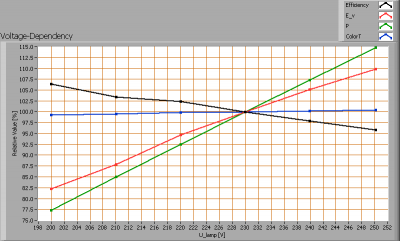
Lamp voltage dependencies of certain light bulb parameters, where the value at 230 V is taken as 100 %.
There is a dependency from the applied voltage. And the dependency there is, is also linear with applied lamp voltage. It indicates that the used power converter inside the lamp behaves in a stable manner
To check whether this dependency can lead to visible changes in illuminance for possible grid voltage changes, just check what variations occur when the lamp voltage varies around 230 V + and – 5 V. Then the illuminance varies between + and – 3 % and will not be visible or noticeable.
Warm up effects
After switch on of a cold lamp, the effect of heating up of the lamp is measured on illuminance E_v [lx], color temperature CT or correlated color temperature CCT [K], the lamp power P [W] and the luminous efficacy [lm/W].
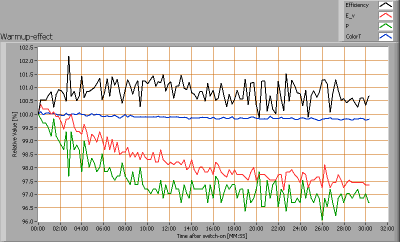
Effect of warming up on different light bulb parameters.
No noticeable effects due to the warming up. After 15 minutes the light’s temperature is stable.
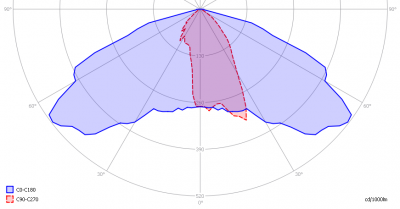
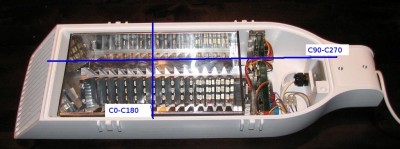
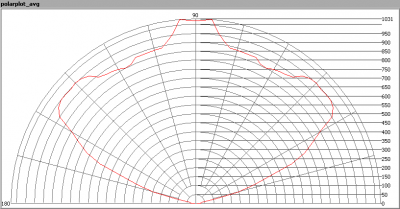
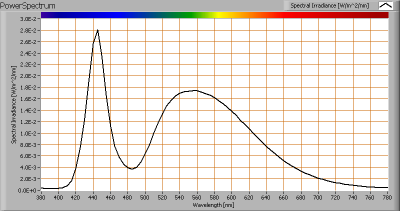
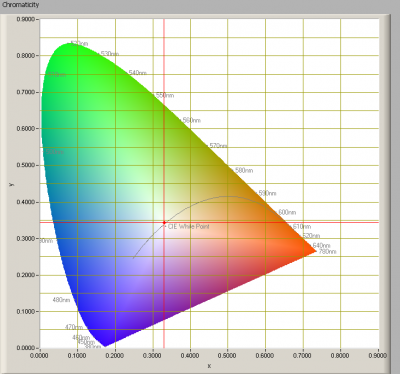
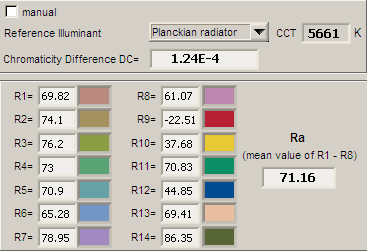



Most popular posts